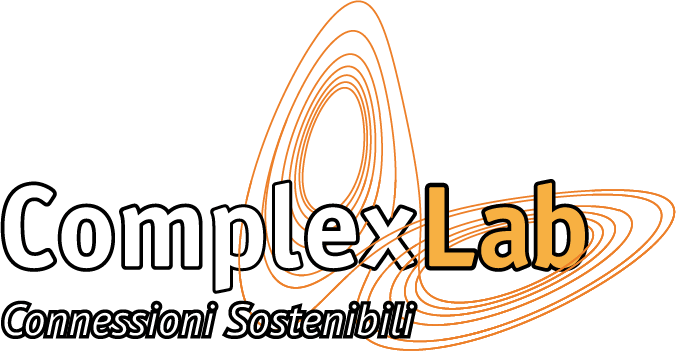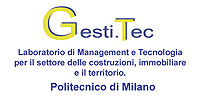Facility management e finanza immobiliare
[To better understand how to exploit Opportunities from a modern and complex Facility&Property Management, with today Clients, Suppliers or Investors and by attracting via Web new ones consistent with your own Values, contacts us: redazione@complexlab.it ]
The job of the Property Manager is a complex one: it takes the property professional into manifold situations, often very dissimilar one from the other, which require a wide vision in order to determine what added value can be achieved from a property asset.
When the Property Manager operates with a vacant building that requires major renovation works, he/she must prepare several technical and economic project solutions for the owners, for them to take their decision based on adequate information.
The case study here described is an office building that had one tenant only until one year ago; now the property is vacant.
The building is in poor service conditions as far as finishes and systems are concerned, and it requires interventions to become compliant with the regulations in force. Therefore it cannot be offered for rent in its current status.
Description of the building
Location
The building is located in a municipality of the first suburban belt of a major city in Northern Italy, close to an important road axis. The building faces the main road that takes to town, which provides an excellent connection with highways; it is well served by public transportation means.
The area is characterised by mixed-use buildings with a strong presence of dwellings, offices and commercial activities.
Building structure
The property was built in the second half of the 1970’s and it consists in a single unit of five floors above the ground, a basement and a fully underground level, for a gross floor area of 9,900 sqm.
The load-bearing frame was made with reinforced concrete beams and pillars, and floors in bricks and cement. The structure of the building includes also the stairwells and the lifts, enclosed in a reinforced concrete frame and adequately dislocated throughout the building. The curtain wall facades include some blacked glass elements.
The electromechanical systems of the building were made 15 years ago.
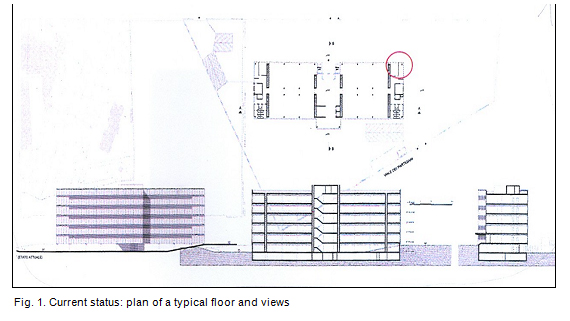
Technical data of the building:
- land surface (Ls): 7,174.68 sqm;
- gross floor area (Gfa): 9,900 sqm;
- maximum height: no. 5 floors above the ground;
- building ratio index (Bi): 0.89 sqm/sqm;
- covered area (Ca): 1.487.35 sqm;
- covering ratio (Cr): 20,7%;
- virtual height: 3.30 m (art. 4.2.7 of NTA – technical implementation regulations);
- volume (V): 32.670 sqm (sqm 9.900 x 3.30 l.m);
- private car-park area: 2.673.89 sqm;
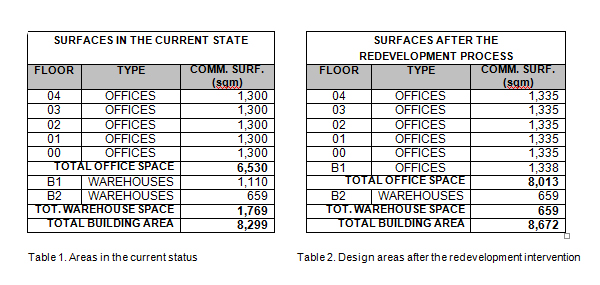
Town-planning regulations
The Municipality where the building stands has produced its Town-Planning Scheme (PRG) amended with a General Alteration.
The proposed intervention falls under the area of “Completion and integration of the consolidated town” in the “Area for consolidated industrial and office settlements”.
The reference Area accepts buildings with industrial, office and partly residential destinations of use (max Gfa = 150 sqm for the existing land units with a productive Gfa not lower than 1,000 sqm), and it accepts the commercial destination of use within the limit of 20% of the allowed Gfa (average- and large-size trade is excluded).
In these estates direct construction interventions are authorized for the following purposes:
- maintenance;
- conservative restoration;
and provided that the destination of use remains unchanged or falls within the ones authorized in this area:
- building renovation (including demolition and subsequent faithful reconstruction);
- extension;
- addition of extra storeys;
- new building (if on lots with Ls not exceeding 2,000 sqm).
For any other intervention, including the demolition with non-faithful reconstruction, preliminary approval of the Implementation Plan is required.
The parameters, the indexes and the standards in the PRG in force for office buildings are as follows:
- building ratio index (Bi): 2 sqm/sqm;
- covering ratio (Cr): 50%;
- maximum height (H max): seven floors above the ground;
- minimum standard for the interventions under the implementation plan: 1 sqm for every sqm of Gfa.
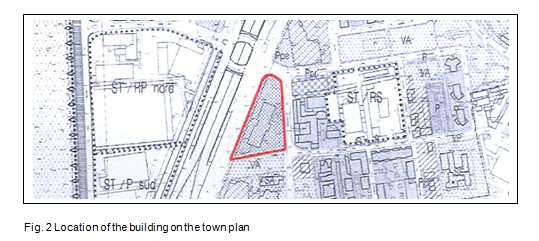
Definition of the aims and targets of the intervention
When analysing the building object, the Property Manager can take two methods of intervention into consideration:
- conservative maintenance;
- development action.
Definition of the model for the assessment of intervention prospects
In order to provide the owners with a concise analysis, definite data are required to be analyzed under the assessment model and to define the variables involved.
The assessment model here adopted is the Discounted Cash Flow (DCF), because it allows defining the net profit from the development operation in clear terms.
The Discounted Cash Flow (DCF) method brings cash flows to date, i.e. it calculates the current value (as of the date of the estimate) resulting from the sum of the cash flows (revenues less costs) foreseen over a specified period of time.
Assumptions
We assume that at the end of the period, the building is transferred at a value calculated by capitalizing the revenue in the last year with an exit capitalization rate that is suitable for the type, the location and the preservation status of the building.
The resulting value is added to the operating revenue in the last year, to be discounted with an adequate discount rate at the present time.
Discount rate
The discount rate was derived from the current, average economic and financial contexts in the capital market (the rates applied on real estate operations), considering the real profitability of low-risk, medium-to-long term financial operations to which a correction element is added or deducted according to the characteristics of the asset.
Revenues
The rent is the existing one, or it is estimated based on the type, the destination of use, the location and the trend in the local market for buildings of the same type.
Costs to be borne by the owners
The profit generated by the building is subject to these operating costs:
- local property tax (I.C.I.);
- insurance (0.50% of the reconstruction costs for newly built units);
- project management (8% of intervention costs);
- agency (10% of revenues when operating);
- operating costs – ordinary maintenance (2% on revenues);
- renovation costs (capital expenditure) or extraordinary maintenance costs.
Cash flows
The analysis of the different hypotheses for the development of the building evaluated the following aspects, among others:
- physiological vacancy (starting at the expiry of the individual lease agreements), that varies case by case according to the areas that become vacant and must be let again;
- rent continuity with a trend that is in line with inflation (2.00%), also in case of relocation;
- charging all the flows as soon as they are generated.
Once the operating revenue is calculated as the difference between the total revenues and the total costs in a year, the revenues relating to all the years in the defined time frame are calculated and then discounted to get the net present value (NPV) of the asset, i.e. its most likely market value.
To assess whether a development operation is attractive, the values of IRR and NPV are taken into consideration. IRR is nothing but the “interest (or discount) rate determined by the return of the invested capital: in other words, IRR is the rate that makes the NPV equal to zero, i.e. the ratio that equals the positive flows and the negative flows of an operation”.[1]
Before analyzing the two proposed intervention scenarios, please note that the right time to invest is when the NPV is positive and the IRR is higher than the discount rate; otherwise if the NPV is negative and the IRR is lower than the discount rate, the project is not a good opportunity to invest in.
How to apply the prospect assessment model to the development project
Two different scenarios were analyzed that represent as many development hypotheses:
- conservative maintenance;
- redevelopment.
In case of redevelopment, three further scenarios were hypothesized that we are going to analyze:
- redevelopment with a delay in works;
- redevelopment with higher costs;
- redevelopment with a delay in works and higher costs.
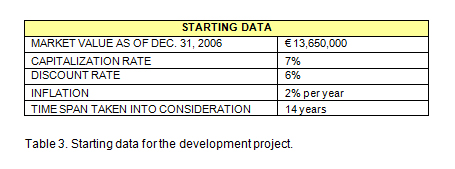
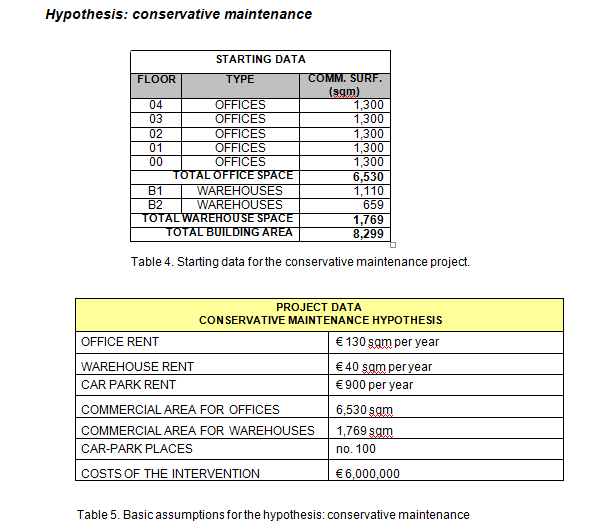
As highlighted by the Discounted Cash Flow (DCF) in the “conservative maintenance” hypothesis (Table 6), the investment is economically not good because the NPV is negative (-4,266,000 €) and the IRR is lower than the discount rate (3.334% < 6.00%).
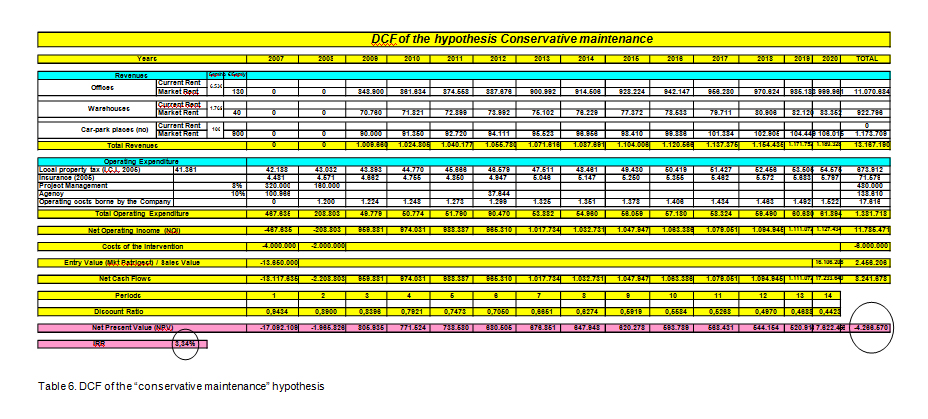
Hypothesis: redevelopment
The redevelopment intervention consists in turning the warehouse space in the basement and some technical rooms into office space.
The better image thus provided to the building and the total remaking of systems and internal/external finishes call for an increase in rent from the value of € 130/sqm to the value of € 180/sqm for office space, from € 40/sqm to € 60/sqm for warehouses and from € 900/per year to € 1,200 per year for every car-park place.
The following table contains the surfaces obtained after the redevelopment intervention, with an increase in commercial office space by 1,480 sqm and a reduction in commercial warehouse space by 980 sqm.
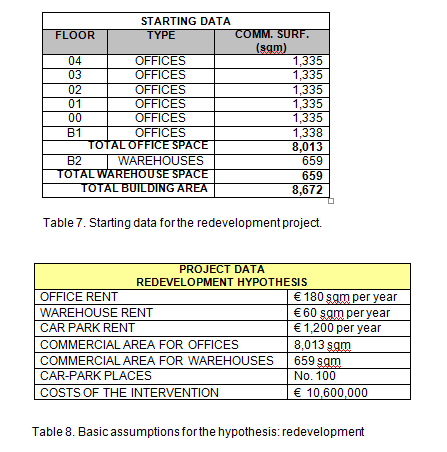
As highlighted by the DCF in the “redevelopment” hypothesis (Table 9), the investment is economically good because the NPV is positive (+326,108 €) and the IRR is higher than the discount rate (6.15% > 6.00%).
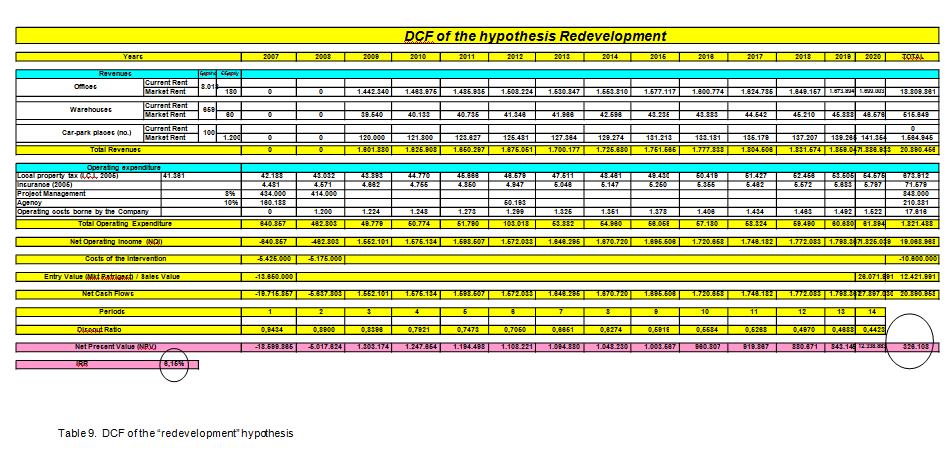
Within the “redevelopment” hypothesis three alternatives were introduced and analyzed: the effect of a 6-month delay in the completion of works, an increase in costs and finally, the effect of both criticalities – i.e. delay in works and higher costs.
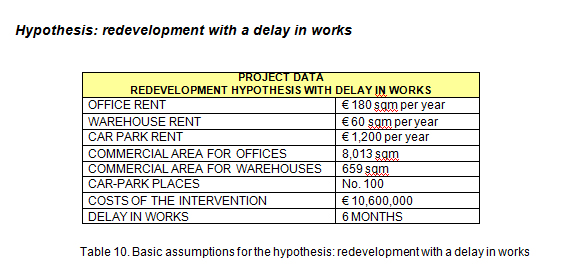
In the case of redevelopment with a delay in the completion of works, the intervention is economically unfavourable because the NPV is negative (-270,816 €) and the IRR is lower than the discount rate (5.88% < 6.00%) as evidenced by the DCF in Table 11.
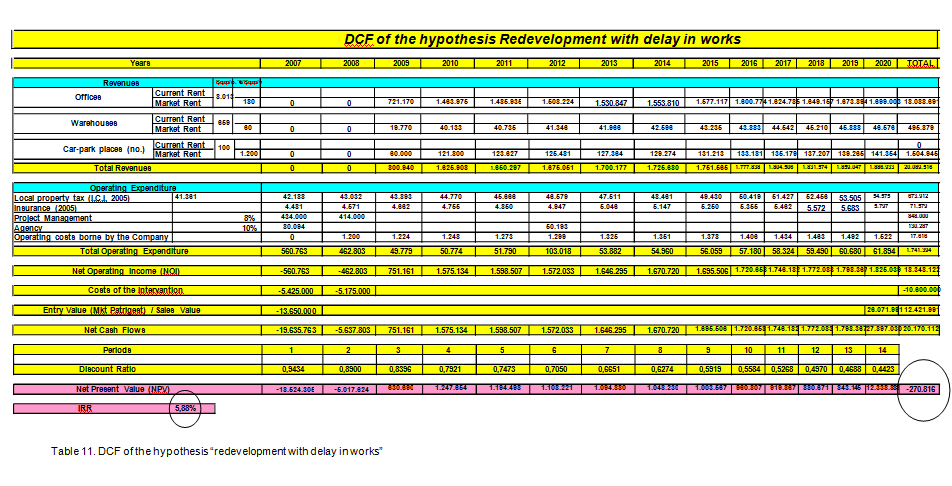
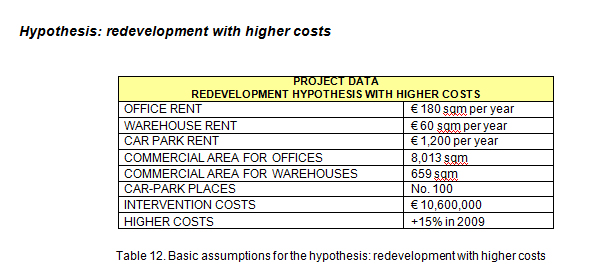
As in the previous hypothesis, the redevelopment intervention with higher costs is economically unfavourable because the NPV is negative (-1,008,887 €) and the IRR is lower than the discount rate (5.55% < 6.00%) as evidenced by the DCF in Table 13.
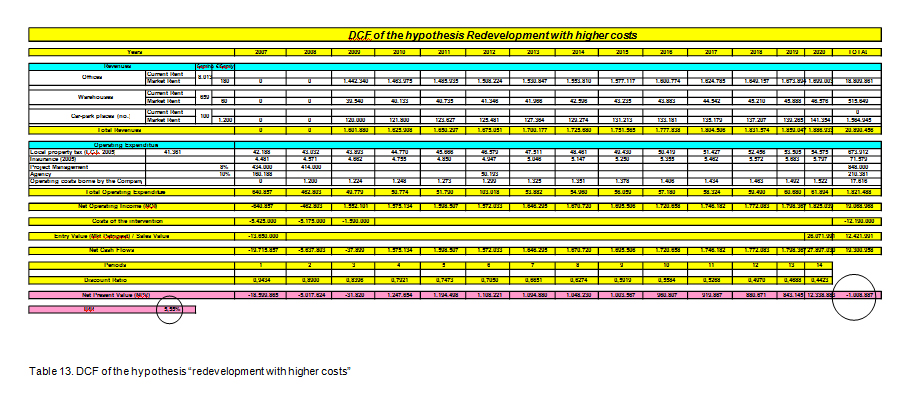
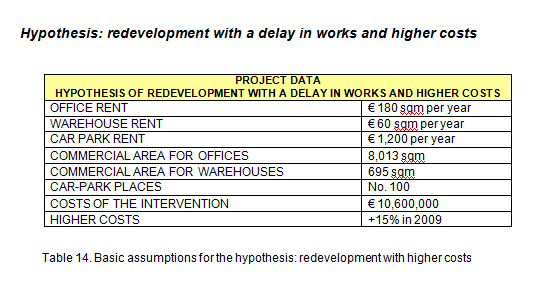
When assuming redevelopment with a delay in works and higher costs, the sum of the two criticalities cannot but result in the lack of any advantage in doing this intervention; the NPV becomes negative (-1,605,811 €) and the IRR is lower than the discount rate (5.28% < 6.00%) as evidenced by the DCF in Table 15.
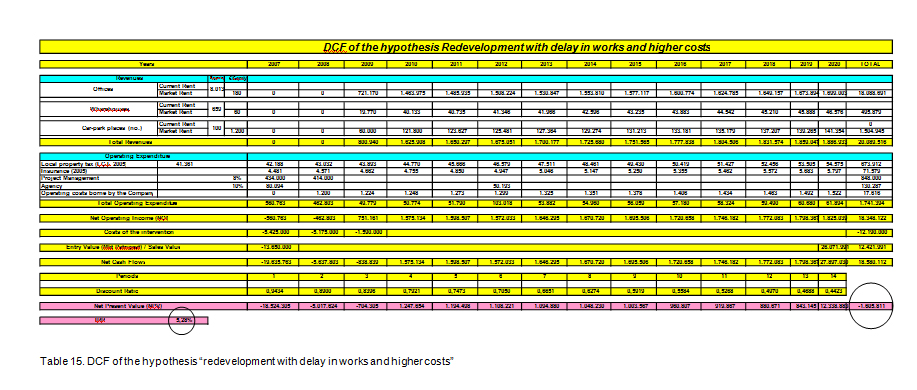
Conclusions
The approach here adopted allows a thorough analysis of the different hypotheses and criticalities relating to a property development project and, therefore, defining the technical and economic targets of the same project:
- redevelopment costs;
- performance times;
- extending the functionality of the building, strengthening its architectural image/appeal, increasing the rentable area, the number of car-park places, and generally the services offered by the building;
- the rent derived from the building once the development process is over;
- management costs.
These targets mostly depend upon the knowledge of the Property Manager’s organization that was charged with the management of the development process.
These targets are going to set an unbreakable bond, to be agreed upon in a contract by all the technical players implementing the development process:
- the Project Management organization (representing the operating arm of the Property Management service) shall coordinate the designers and, later, the construction company and the systems installation firm (or several firms, if the contract is divided into stages) assigned to the works. The Project Management organization shall monitor overall management and provide reports during the design and the operating stages, such reports being essential for the subsequent development process;
- the designer(s) charged with the project shall act in full compliance with the targets of the development project and in strict times, spending his/her professional skills to improve the functionalities, the useful surfaces and the services of the building in a tangible way;
- the construction company(ies) and systems installation firm/s will abide by the signed agreement, in full compliance with the targets of the development project: deadlines, costs and quality workmanship.
References
- Franco PRIZZON, “Gli investimenti immobiliari”, Celid, Torino, 1995;
- Oliviero TRONCONI, “Metodi e strumenti del Property Management”, Il Sole 24 Ore, Milano, 2007;
- Oliviero TRONCONI, Andrea CIARAMELLA, Barbara PISANI, “La gestione di edifici e patrimoni immobiliari”, Il Sole 24 Ore, Milano, 2007.
[1] F. Prizzon, “Gli investimenti immobiliari”, Celid, Torino, 1995.
